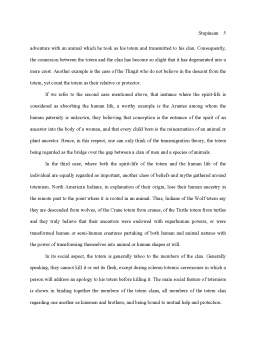Extras din referat
“Ordinarily, a sketch of the mythology of a people should include to a great extent its religion as well. Indeed in a large degree primitive religion is mythology, and the two if considered separately will often be found to originate in a common source.” (Miner, 138)
As the above quotation explicitly states mythology and religion intermingle in the minds and souls of almost all primitive cultures, permeated by fear and superstitions. Their world is soaked by spirits originating either from inanimate objects or natural phenomena, from the sky, earth, wind, moon, water, from animals endowed with magical powers to protect the life of those whose guardian spirits they have been assigned to become. Real world, spirit-world and the mysterious realm of dreams are one and the same for the North American Indian, with visions, quests into the Spirit-land and the Underworld, with shamans who could enter other people’s dreams and employ thaumaturgical practices which closely follow modern psychoanalytical theories.
The opinion prevails that among the most savage nations in the world there are beings superior to themselves, who manage by their power and wisdom, the affairs of this world. The idea of God, often strange and sinister in nature perhaps, was powerfully expressed in the Indian mythologies. Each tribe possessed its own word to signify ‘spirit.’, for example manitou was the term used for divinity in the woodlands, and waken, among Plains Indians. Some of these words meant ‘that which is above,' ‘the higher one,' ' the invisible,' and these attributes accorded to deity show that the original Indian conception of it was practically the same as those which obtained among the primitive peoples of Europe and Asia. The idea of God was that of a great prevailing force who resided in the sky. The savage or primitive man observed that all brightness emanates from the firmament above him and, with his eyes dazzled by its splendour, he concluded that it must be the abode of the source of all life, of all spiritual excellence. Therefore, in most cases, the Supreme Being is the personification of the sky, or of the sun, in the western half of the North American continent. Often called the Great Spirit, this divinity is thought to have infinite powers and it is to him that they ascribe their victories in the field of battle and their success in the chase.
“The supreme being is closely associated with the axis mundi, or world pillar. The Delaware Indians say that he grasps the pole that holds up the sky and is the center of the world. In ceremonial life the world pole, or world tree, is the central cultic symbol in the great annual rites of peoples of the Eastern Woodlands, the Plains, the Basin, and the Plateau”. (Hultkrantz 6651)
It is generally believed that the mythologies of the American Indians are infinitely richer in creative and deluge myths than those of any other race on earth. The creation-myths of the various Indian tribes differ as much from one another as do those of Europe and Asia. In some we find the great gods moulding the universe, in others we find them merely discovering it. For example, The Muskhogean Indinans believe that in the beginning there was only water visible all around and two turtles flew hither and thither to find a place for rest. Suddenly, one of them observed a frail blade of grass spring above the surface, and then, the entire solid earth followed gradually.
“A great hill, Nunne Chaha, rose in the midst, and in the centre of this was the house of the deity Esaugetuh Emissee, the ‘Master of Breath.' He took the clay which surrounded his abode, and from it moulded the first men.” (Spence 108)
What is so striking when one reads or hears this myth is its close resemblance of to the one that could be found in the Bible, in the Book of Genesis, the deluge and the turtles are elements common to both, while the manufacture of the men out of mud is something that Christian faith preaches for thousands of years.
Preview document
Conținut arhivă zip
- North American Indians - Spirituality and Cosmogonic Myths.doc
















